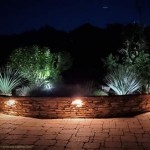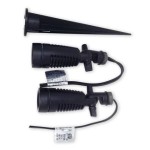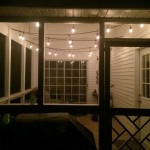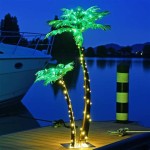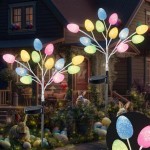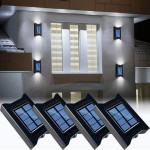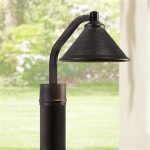Outdoor Waterproof Light Bulbs: Illuminating and Securing Outdoor Spaces
Outdoor lighting plays a crucial role in enhancing the usability, safety, and aesthetic appeal of residential and commercial properties. Selecting the right type of light bulb for outdoor fixtures is paramount, and in this context, waterproof light bulbs offer significant advantages over standard options. These specialized bulbs are engineered to withstand harsh environmental conditions, providing reliable illumination regardless of weather patterns.
The following explores the characteristics, benefits, selection criteria, and maintenance considerations associated with outdoor waterproof light bulbs, aiming to provide a comprehensive understanding for informed decision-making in outdoor lighting applications.
Understanding Waterproofing and its Importance in Outdoor Lighting
The term "waterproof" in the context of light bulbs refers to the bulb's ability to function reliably when exposed to water. This is achieved through specific design and manufacturing processes that protect the internal components of the bulb from moisture ingress. The level of waterproofing is typically indicated by an Ingress Protection (IP) rating. The IP rating consists of two digits: the first digit represents the protection against solid objects (dust, dirt), and the second digit represents the protection against liquids (water). For outdoor applications, an IP rating of IP65 or higher is generally recommended. IP65 signifies that the bulb is protected against water jets from any direction, while higher ratings like IP67 or IP68 offer even greater protection against immersion.
The importance of waterproofing in outdoor lighting stems from the inherent exposure to rain, snow, humidity, and even accidental splashes. Standard light bulbs, not designed to withstand such conditions, are susceptible to damage and failure due to moisture intrusion. This can lead to short circuits, corrosion of internal components, and ultimately, bulb burnout. Waterproof light bulbs, on the other hand, provide a reliable and long-lasting lighting solution, minimizing the need for frequent replacements and reducing maintenance costs.
Furthermore, the safety aspect of using waterproof light bulbs cannot be overstated. Moisture intrusion into electrical components poses a significant electrocution hazard. Waterproof bulbs, with their robust sealing and protective design, significantly reduce this risk, ensuring a safer environment for residents, visitors, and maintenance personnel.
Key Benefits of Using Outdoor Waterproof Light Bulbs
The advantages of utilizing waterproof light bulbs in outdoor settings extend beyond basic functionality. Several key benefits contribute to their widespread adoption in both residential and commercial applications.
Enhanced Durability and Lifespan: Waterproof light bulbs are built to endure harsh weather conditions, including heavy rain, snow, extreme temperatures, and humidity. This robust construction translates into a significantly longer lifespan compared to standard bulbs. The protective sealing prevents moisture from damaging internal components, reducing the likelihood of premature failure and the need for frequent replacements. This durability not only saves money on replacement costs but also minimizes the time and effort required for maintenance.
Improved Safety: The paramount advantage of waterproof light bulbs is the enhanced safety they provide. Moisture ingress into electrical components is a leading cause of electrical hazards, including short circuits and electrocution. Waterproof bulbs, with their specialized sealing and protective design, effectively prevent water from reaching sensitive internal components, significantly reducing the risk of electrical accidents. This is especially crucial in outdoor environments where children, pets, and visitors might come into contact with lighting fixtures.
Consistent Performance: Outdoor waterproof light bulbs are designed to maintain consistent performance even under varying weather conditions. Unlike standard bulbs that may flicker or dim in response to changes in humidity or temperature, waterproof bulbs deliver stable and reliable illumination. This consistent performance ensures optimal visibility and enhances the safety and security of outdoor spaces. The reliability of the light output also contributes to a more aesthetically pleasing and functional environment.
Reduced Maintenance Costs: The extended lifespan and enhanced durability of waterproof light bulbs directly translate into reduced maintenance costs. Fewer replacements are required, minimizing the labor and material expenses associated with bulb changes. Additionally, the resistance to corrosion and other forms of weather-related damage contributes to lower overall maintenance requirements for the entire lighting system. This cost-effectiveness makes waterproof light bulbs a financially sound investment for both residential and commercial properties.
Versatile Applications: Outdoor waterproof light bulbs are suitable for a wide range of applications, including garden lighting, patio lighting, deck lighting, driveway lighting, pathway lighting, and security lighting. Their adaptability to various fixtures and settings makes them a versatile solution for illuminating diverse outdoor spaces. The availability of waterproof bulbs in different wattages, color temperatures, and styles further enhances their versatility, allowing users to customize their outdoor lighting design to meet specific needs and preferences.
Factors to Consider When Selecting Outdoor Waterproof Light Bulbs
Choosing the right outdoor waterproof light bulb requires careful consideration of several factors to ensure optimal performance, longevity, and energy efficiency. A thorough evaluation of these factors will help in selecting the most suitable bulbs for specific outdoor lighting applications.
IP Rating: As previously mentioned, the IP rating is a crucial indicator of a light bulb's waterproofing capabilities. For general outdoor use, an IP rating of IP65 or higher is recommended. IP65 provides protection against water jets from any direction, making it suitable for most outdoor applications. For areas that are prone to flooding or submersion, such as ponds or fountains, a higher IP rating like IP67 or IP68 is necessary.
Bulb Type and Technology: Various types of light bulbs are available in waterproof versions, including LED, incandescent, halogen, and compact fluorescent (CFL). LED bulbs are generally the preferred choice due to their superior energy efficiency, long lifespan, and low heat emission. While incandescent and halogen bulbs are less expensive upfront, they consume significantly more energy and have a shorter lifespan, resulting in higher long-term costs. CFL bulbs offer a compromise between energy efficiency and cost, but they contain mercury, which requires careful disposal. In addition to the bulb type, consider the technology used within the bulb. Features like dimmability, color changing capabilities, and smart home integration can further enhance the functionality and convenience of outdoor lighting.
Wattage and Brightness: The wattage of a light bulb determines its energy consumption, while the lumen output indicates its brightness. When selecting outdoor waterproof light bulbs, it is important to choose the appropriate wattage and lumen output to achieve the desired level of illumination without wasting energy. Consider the size of the area to be illuminated and the intended purpose of the lighting. For pathway lighting, lower wattage bulbs with soft, diffused light are often sufficient, while larger areas like patios and driveways may require higher wattage bulbs with brighter light output. LED bulbs offer a wide range of lumen outputs at significantly lower wattages compared to traditional bulbs, making them an energy-efficient choice.
Color Temperature: The color temperature of a light bulb, measured in Kelvin (K), determines the color of the light it emits. Lower color temperatures (2700K-3000K) produce a warm, yellowish light that is often preferred for creating a cozy and inviting atmosphere. Higher color temperatures (4000K-5000K) produce a cool, bluish-white light that is better suited for task lighting and security applications. When selecting outdoor waterproof light bulbs, consider the desired ambiance and the intended use of the lighting. Warm white light is often preferred for patios and gardens, while cool white light is commonly used for driveways and security lighting.
Bulb Shape and Size: Outdoor waterproof light bulbs are available in a variety of shapes and sizes to fit different types of fixtures. Ensure that the selected bulb is compatible with the existing or planned lighting fixture. Consider the aesthetic appeal of the bulb shape and size in relation to the overall design of the outdoor space. Common bulb shapes include A-shape, globe-shape, candelabra-shape, and reflector-shape. The size of the bulb should also be appropriate for the fixture to ensure proper fit and optimal light distribution.
Material and Construction: The materials used in the construction of outdoor waterproof light bulbs play a crucial role in their durability and longevity. Look for bulbs made from high-quality materials that are resistant to corrosion, UV radiation, and impact. Common materials used in outdoor waterproof light bulbs include glass, polycarbonate, and aluminum. The construction of the bulb should also be robust and well-sealed to prevent moisture ingress. Inspect the bulb for any signs of damage or defects before installation.
Warranty and Certifications: A warranty provides assurance of the quality and reliability of the product. Look for outdoor waterproof light bulbs with a reasonable warranty period to protect against defects in materials and workmanship. Additionally, check for certifications from reputable organizations such as UL (Underwriters Laboratories) or ETL (Electrical Testing Laboratories). These certifications indicate that the bulb has been tested and meets safety standards.
Maintaining Outdoor Waterproof Light Bulbs
Even with their robust construction, outdoor waterproof light bulbs require periodic maintenance to ensure optimal performance and longevity. Regular cleaning and inspection can help prevent damage and extend the lifespan of the bulbs.
Cleaning: Outdoor light bulbs are susceptible to accumulating dirt, dust, and debris, which can reduce their light output and overall efficiency. Clean the bulbs regularly with a soft, damp cloth. Avoid using harsh chemicals or abrasive cleaners, as these can damage the bulb's surface and sealing. Ensure that the power is turned off before cleaning the bulbs to prevent electrical shock.
Inspection: Periodically inspect the bulbs for any signs of damage, such as cracks, chips, or discoloration. Check the wiring and connections for signs of corrosion or loose connections. Replace any damaged bulbs or wiring immediately to prevent electrical hazards and ensure proper operation. Pay particular attention to the sealing around the bulb and fixture to ensure that it remains intact and waterproof.
Fixture Maintenance: The lighting fixture itself also requires maintenance to ensure proper operation and protection of the light bulb. Clean the fixture regularly to remove dirt, dust, and debris. Inspect the fixture for any signs of corrosion or damage. Ensure that the fixture is properly grounded and that all wiring is securely connected. Replace any damaged or corroded parts of the fixture to maintain its integrity and safety.
Seasonal Adjustments: In areas with extreme weather conditions, it may be necessary to make seasonal adjustments to outdoor lighting. During winter months, snow and ice can accumulate on the light bulbs and fixtures, potentially causing damage. Clear snow and ice from the bulbs and fixtures regularly to prevent excessive weight and stress. During summer months, prolonged exposure to sunlight can cause discoloration or fading of the bulb's surface. Consider using bulbs with UV protection to minimize this effect.
Proper Storage: When replacing light bulbs, store the old bulbs properly to prevent damage or breakage. If the bulbs contain mercury, such as CFLs, dispose of them according to local regulations. Store new light bulbs in a cool, dry place away from direct sunlight and extreme temperatures.

Outdoor G40 String Lights Festive Patio And Garden Lighting Chronos

Daybetter 100ft Outdoor String Lights For Outside G40 Patio With 50 Edison Vintage Bulbs Waterproof Connectable Hanging Garden Backyard Porch Balcony Party Com

96ft Smart Wifi Outdoor String Lights 30 Led Bulbs Etl Listed And Ip65 Bn Link

Solar Light Bulb Outdoor Waterproof With Hook Lamp Garden Courtyard Emergency Energy Saving Fruugo Nl

Newhouse Lighting Outdoor 48 Ft Plug In S14 Edison Bulb Weatherproof String Light With 16 Led Bulbs 2700k Black Cstringled18 The Home Depot

Sl101 Led Low Voltage Bistro Outdoor String Lights Kings Lighting

Costway 96ft Led Outdoor Waterproof Commercial Grade Patio Globe String Light Bulbs Target

Waterproof Ip65 Hanging Light Bulb Chains String Outdoor 50ft 15 Bulbs China Led Lights Made In Com

Philips Hue White Outdoor Par38 Led 120w Equivalent Waterproof Dimmable Smart Wireless Flood Light Bulb 2 Pack 476820 The Home Depot

Costway 48ft Led Outdoor Waterproof Commercial Grade Patio Globe String Lights Bulbs Target
Related Posts
